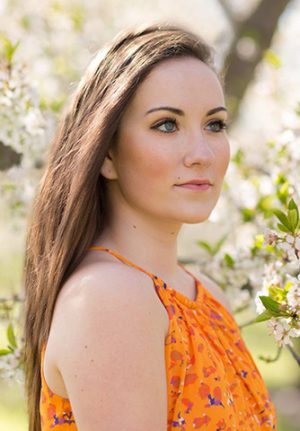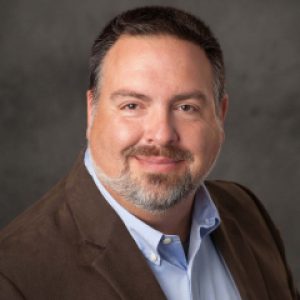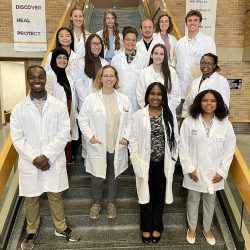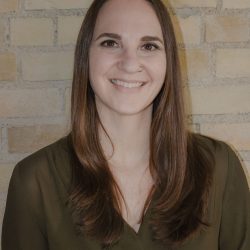November: a time for joining with friends and family to give thanks, the month in which we turn our eyes to the full Beaver Moon, and the official time for Native American Heritage Month, when we recognize the historical and modern-day contributions of Native American individuals, as well as celebrate cultures and traditions.
We celebrate the month by speaking to members of the MSU College of Veterinary Medicine community about a key topic: “How can the veterinary community be more inclusive to Native American individuals?” Common threads identified include youth mentorship, improving veterinary care in underserved areas, and financial support.
Mikenna Ludka, Doctor of Veterinary Medicine Class of 2023

About: “Boozhoo! (Hello) I am an MSU alumna and current third-year veterinary student at MSU. I was born and raised in Traverse City, Michigan and I am a member of the Sault Ste. Marie Tribe of Chippewa Indians. My Native lineage comes from my maternal grandfather (my PaPa) and from a very young age he always instilled in me the importance of nurturing our environment and the animals that inhabit it. My family’s strong connection with animals was passed on to me and this has greatly influenced my passion surrounding preventative and accessible veterinary care. Miigwech! (Thank you)”
How can the veterinary community be more inclusive to Native American individuals?
“I think a major barrier for Native Americans joining our profession is the lack of exposure to the veterinary profession in their communities. Most native communities are in under-served rural areas, where poverty and geographic isolation make regular veterinary care inaccessible. Due to this, the younger generations growing up in our Native communities have limited opportunities to interact with veterinarians who could potentially serve as a role model for them to one day join the profession. After graduation, I plan to spend some of my time volunteering in Native communities providing low-cost veterinary services and animal husbandry education. While I am in these communities, I hope to aid in community education and increase recognition of what our profession does and how it can benefit their community, and hopefully inspire future veterinarians to join the crusade. If we can show Native Americans the positive impact our profession can have on their community, this could encourage the younger generation to pursue this profession in order to give back to their community. Once in veterinary school, it is critical for Native American students to be able to have support and mentorship from people who understand their culture and the different challenges they faced to get here. Cultivating the work being done in our BIPOC veterinary organizations will hopefully improve our ability to be more inclusive to Native Americans.”
Hunter Wojtas, Doctor of Veterinary Medicine Class of 2024

About: Hunter, a member of the Doctor of Veterinary Medicine Program’s Class of 2024, is Anishinaabe/Odawa and an enrolled member of the Sault Ste. Marie Tribe of Chippewa Indians.
How can the veterinary community be more inclusive to Native American individuals?
“The main thing that the veterinary community can do to be more inclusive of Native American individuals is to educate themselves. A good place to start is by learning about the past of the Indigenous peoples in your area because Indigenous history in the United States is rooted in erasure. While the recent outcry of residential schools shone a spotlight on the oppression plaguing our history, I have talked to local non-Native people who do not even know that Michigan had its own residential schools or what they are. As a consequence of these institutions, many Indigenous people cannot speak their language or missed learning traditions. Understanding this history is key in understanding how Indigenous people are impacted today. I think it is also important to recognize that there is not just one way to be Indigenous and to understand the diversity that encompasses Native peoples. There are hundreds of tribes throughout the United States, and each tribe and group have their own unique values and traditions. We are diverse and cannot be put into one box of how an Indigenous person should look and act. There are Indigenous writers, skaters, actors, singers, and lawyers, and I encourage people to listen to a multitude of Indigenous voices to understand this diversity. Fill your social media with Indigenous artists, support representation in TV shows and movies, and read books by Native authors to uplift these diverse voices.”
Dr. Nicole Insko, Doctor of Veterinary Medicine Class of 2021 Graduate

About: Dr. Nicole Insko is a member of the Turtle Clan of the Sault Ste. Marie Ojibwe Tribe located in Northern Michigan who graduated from Michigan State University College of Veterinary Medicine in May 2021. Although her tribal culture and language was taken from her family by residential schools, she has been striving to relearn the knowledge of her tribe and people and reconnect to her history. Dr. Insko grew up in various states but calls Wisconsin home and has been working at Companion Animal Hospital in Milwaukee, where she is learning more about exotics while providing good laughter and good medicine to her staff and clients. Her interests in veterinary medicine include ultrasound, surgery, and everything feline. When she isn't working, she can be found napping with her two cats, catching up on her shows, or doing crafts such as cross stitch or bead looming.
How can the veterinary community be more inclusive to Native American individuals?
“I think the most important factor is increasing knowledge and access to Indigenous youth about the programs, opportunities, and scholarships available to them. I would not be where I am without the Michigan Indian Tuition Waiver, which I only found out about through a family member. Knowing that there are programs like that to assist us in our journey can make the idea of becoming a part of the veterinary medicine community a reality. In addition, increasing mentorship so that our youth have people within the community to look up to, ask questions, and really help themselves integrate into the community is huge. There are very few veterinary clinics on reservations and finances are often a major hurdle for receiving veterinary care for their pets. Programs such as RAVS (Rural Area Veterinary Services) that provide free care to pets on many reservations across the country are sometimes the only interaction between the local community and the veterinary world. Supporting these organizations and others that reach out to the Indigenous people in our country are a great start to including us in the veterinary community.”
Dr. Kevin Leonard, Assistant Director of Diversity, Equity, and Inclusion

About: Prior to taking on his role at the Michigan State Univeristy College of Veterinary Medicine, as the senior program coordinator with the MSU Multicultural Business Programs, Dr. Leonard provided academic advising, promoted internship opportunities, coordinated tutorial programs, and supervised a staff of 30 tutors who provided services to minoritized business students. Dr. Leonard also has an extensive portfolio in enrollment management, as he previously served at Olivet College as the director of admissions. He has received awards for leadership and service from MSU and his community, the Sault Ste. Marie Tribe of Chippewa Indians. His Native name is Waabshka Mai'ingan N'Dishnihcoz Migizi Doodem; "White Wolf is who I am and Eagle is my Clan." He serves as president of EAGLE (Educating Anishinaabe: Giving, Learning, and Empowering) Native Faculty/Staff Association and as executive board member for CoREM (Coalition of Racial and Ethnic Minorities).
How can the veterinary community be more inclusive to Native American individuals?
“I believe there are three factors that impact Indigenous youth when it comes to college attendance and graduation, which also limit their enrollment in graduate and professional programs like veterinary medicine. The first being the lack of exposure to STEM-related fields of study. Over half of Native American students lack access to the math and science courses they would need to ready them for the college degrees needed to fill the increasing demand for jobs in the STEM fields. Providing Native students with the opportunity to learn STEM subjects, and to learn about veterinary medicine or other STEM careers would increase exposure and would create pathways for this underserved population to enter veterinary medicine, veterinary nursing, or other STEM-related fields.
The second factor is the cost of college/professional degree and the lack of knowledge about the resources available to help cover these costs. The average Native American household income is roughly $49,000. For many Native youth the idea of incurring over $50,000 in loans/debt for an undergraduate degree is therefore unrealistic. As such, funding a professional degree such as veterinary medicine with degree costs well in excess of six figures is incomprehensible to these families. Providing informational sessions about financing one’s education, scholarships, and other funding sources can help make financing a degree more realistic and obtainable for Native students and their families.
Lastly, community is hugely important to Native Americans. For those growing up on or near reservations, they often grew up surrounded by Aunties and Uncles and Grandparents and Cousins. Someone was always looking out for them and they also knew there was always someone nearby they could go to for help/support. Creating and/or providing communities of support to whom Native students can turn to with questions or for support/mentoring helps promote a deeper sense of belonging and improves retention and graduation rates.”



